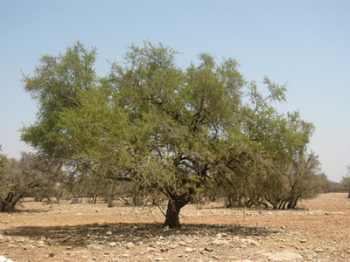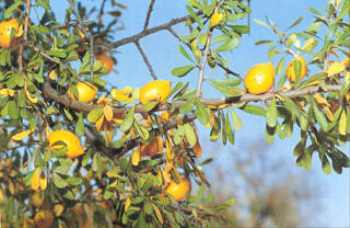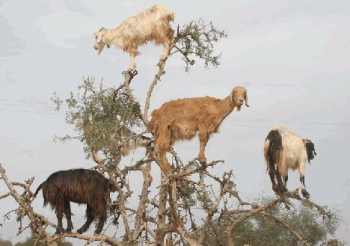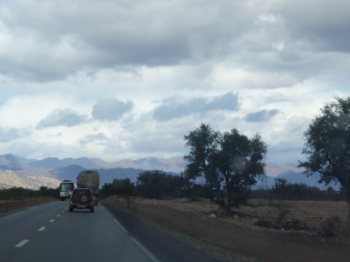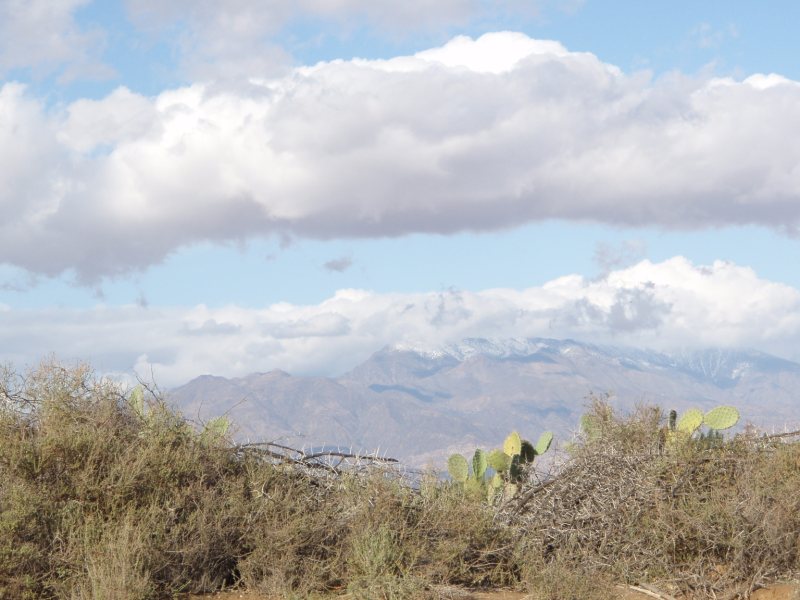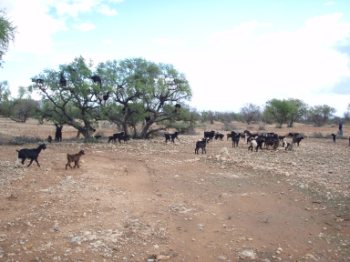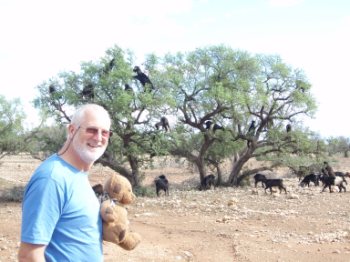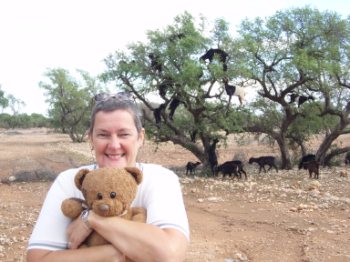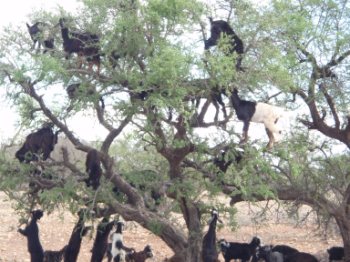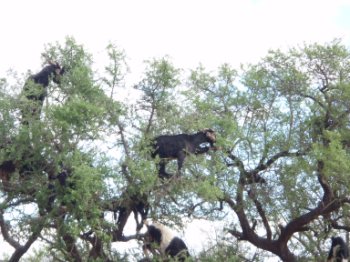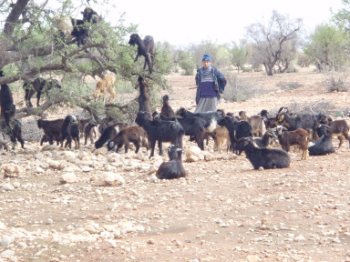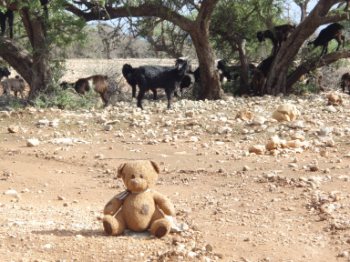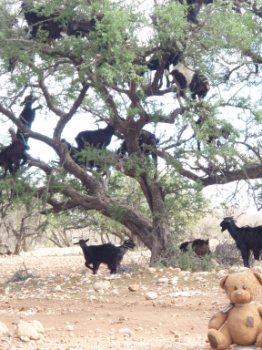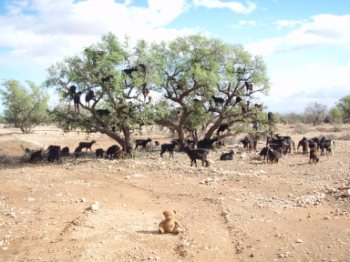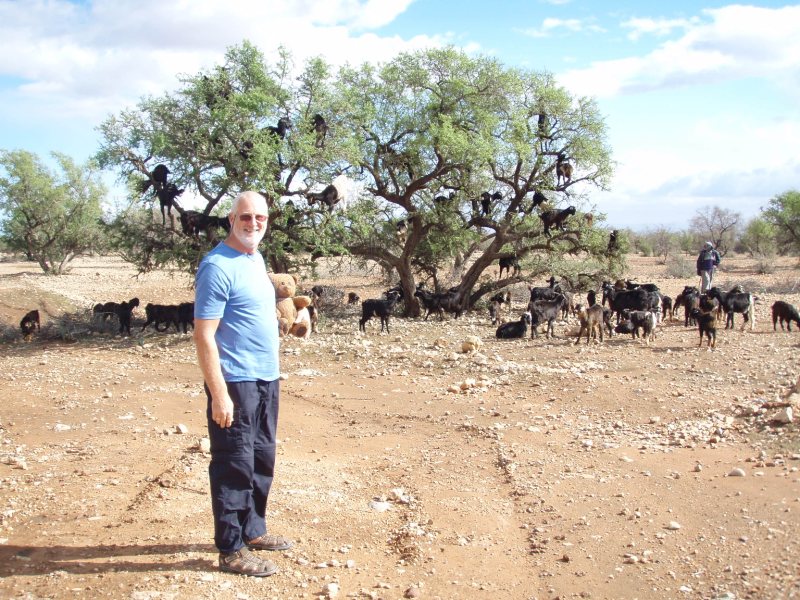Goats in trees

|
Argan Trees The Argan (Argania spinosa ) is a species of tree endemic to the calcareous semi-desert Souss valley of southwestern Morocco and to the Algerian region of Tindouf in the western Mediterranean region. It is the sole species in the genus Argania. Argan grows to 8-10 metres high, and live to 150-200 years old. They are thorny, with gnarled trunks. The leaves are small, 2-4 cm long, oval with a rounded apex. The flowers are small, with five pale yellow-green petals; flowering is in April. The fruit, looking at it quickly, just like the lemon, is 2-4 cm long and 1.5-3 cm broad, with a thick, bitter peel surrounding a sweet-smelling but unpleasantly flavoured layer of pulpy pericarp. This surrounds the very hard nut, which contains one (occasionally two or three) small, oil-rich seeds. The fruit takes over a year to mature, ripening in June to July of the following year.The arganeraie forests now cover some 8,280 km² and are designated as a UNESCO Biosphere reserve . Their area has shrunk by about 50% over the last 100 years, owing to charcoal-making, grazing, and increasingly intensive cultivation. The best hope for the conservation of the trees may lie in the recent development of a thriving export market for argan oil as a high-value product. In some parts of Morocco, Argan takes the place of the olive as a source of forage, oil, timber and fuel in Berber society. Especially near Essaouira, the argan tree is frequently seen with GRAZING GOATS - ITS WRONG I TELL YOU.
The Argan tree. The fruit and it's wrong use as grazing. I had seen the advert on the TV before we left, the Asian couple with grazing goats in a tree behind them as she shyly says "fertility", I knew this to be a true fact, me liking the bizarre, Bear truly believed it was C.G.I. or a 'cut and paste job' Fruit Argan fruit falls in July, when black and dry. Until that time, goats are kept out of the argan woodlands by wardens. Rights to collect the fruit are controlled by law and village traditions. The leftover nut is gathered after consumption by goats, but the oil produced from these nuts has an unpleasant taste, and is not used for human consumption (Nouaim 2005). Argan oilArgan oil is produced by several women's co-operatives in the region. The most labour intensive part of oil-extraction is removal of the soft pulp (used as animal feed) and the cracking by hand, between two stones, of the hard nut. The seeds are then removed and gently roasted. This roasting accounts for part of the oil's distinctive, nutty flavour. The traditional technique for oil extraction is to grind the roasted seeds to paste, with a little water, in a stone rotary quern. The paste is then squeezed between hands to extract the oil. The extracted paste is still oil-rich and is used as animal feed. Oil produced by this method will keep 3-6 months, and will be produced as needed in a family, from a store of the kernels, which will keep for 20 years unopened. Dry-pressing is now increasingly important for oil produced for sale, as the oil will keep 12-18 months and extraction is much faster. The oil contains 80% unsaturated fatty acids, is rich in essential fatty acids and is more resistant to oxidation than olive oil. Argan oil is used for dipping bread, on couscous, salads and similar uses. A dip for bread known as amlou is made from argan oil, almonds and peanuts, sometimes sweetened by honey or sugar. The unroasted oil is traditionally used as a treatment for skin diseases, and has found favour with European cosmetics manufacturers. Argan oil is sold in Morocco as a luxury item (although difficult to find outside the region of production), and is of increasing interest to cosmetics companies in Europe. It was difficult to buy the oil outside Morocco, but in 2001-2002 argan oil became a fashionable food in Europe and North America. It is now widely available in specialist shops and, sometimes, in supermarkets. Its price (USD 40-50$ for 500 ml) is notable compared to other oils.
SO with a non-believer we walked into town to hire a car, we had checked the price on the internet and expected to pay around £92 for three days hire. Not bad I thought. We walked past an office, got invited in and came out with a contract for us both to drive for three days £60, unlimited mileage. We set off at 10:00 am Monday 3rd in search of the open road and the tree climbing goats, a surprise booking at the Gazelle D'Or for Bear, to help him get over the shock.
Spectacular clouds over the Atlas Mountains to our left
After about an hour driving along chatting, we saw them. Now if you type into Google the question " the climbing goats" you find lots of comments, "yeah, pull the other one, my pet dinosaur just sat up and begged". PLEASE YOURSELVES or JUST GO SEE. The best comment I found was "it's the goat herder, he puts them up there" Ok explain them being up twenty feet without a ladder. I took five different videos of them, they not only climb, they jump up, are fearless to get to the tender shoots and we saw a traffic jam of several waiting in a queue to climb.
Bear said. Its wrong, the next thing will be the goats teaching sheep to do it, then mating and the shoats getting their coats caught, next thing in the evolutionary process, THEY'LL GROW WINGS. Mark my words.
I trotted over and gave the goat herder a 100 Dirham note, he looked at it and at first thought it was a 10. He kept getting it out looking and stroking it. We don't think he had ever been given one before, the best £7.00 I have ever spent, him and Bear in shock. The next day we drove past the same area and there were four flocks out, the herder must have told his mates that some crazy tourists paid him for his animals do naturally
"Beds would you like to sit in a branch for a classic shot" "Are you crazy, have you seen the size of those thorns, you do it"
All in all a very shaken not stirred Big Bear |
